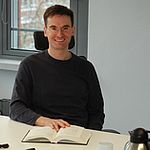How much information on a residually finite group can one recover from its finite quotients? This question has been raised in diverse contexts but it is particularly intriguing for lattices in simple Lie groups. In this research project, we want to investigate to what extend \(\ell^2\)-cohomological properties of groups, in particular lattices, are determined by their profinite completions. The latter will also be investigated as dynamical systems when endowed with translation actions. As geometric outcomes, we will identify situations in which the sign of the Euler characteristic or the volume of a locally symmetric space are determined by the deck transformation groups of its finite sheeted coverings. We will investigate algebraic approximation properties of \(\ell^2\)-cohomology, which should give new insights in the algebraic eigenvalue property. One goal is to establish the Atiyah conjecture for left-orderable groups.
We will start to investigate profinite aspects of \(\ell^2\)-cohomology using rigidity properties of lattices. In the course of this project we further plan to investigate in how far results for lattices extend to larger classes of residually finite groups. For instance, while \(\ell^2\)-acyclicity is a profinite invariant of higher rank lattices, it is unknown whether this holds true for arbitrary residually finite groups. This line of investigations links our project to group theoretic problems which arise in the attempt to construct counterexamples.
Publications
We show that if one of various cycle types occurs in the permutation action of a finite group on the cosets of a given subgroup, then every almost conjugate subgroup is conjugate. As a number theoretic application, corresponding decomposition types of primes effect that a number field is determined by the Dedekind zeta function. As a geometric application, coverings of Riemannian manifolds with certain geodesic lifting behaviors must be isometric.
Related project(s):
58Profinite perspectives on l2-cohomology
We construct pairs of residually finite groups with isomorphic profinite completions such that one has non-vanishing and the other has vanishing real second bounded cohomology. The examples are lattices in different higher rank simple Lie groups. Using Galois cohomology, we actually show that \(\operatorname{SO}^0(n,2)\) for \(n \ge 6\) and the exceptional groups \(E_{6(-14)}\) and \(E_{7(-25)}\) constitute the complete list of higher rank Lie groups admitting such examples.
Related project(s):
58Profinite perspectives on l2-cohomology
For every number field and every Cartan Killing type, there is an associated split simple algebraic group. We examine whether the corresponding arithmetic subgroups are profinitely solitary so that the commensurability class of the profinite completion determines the commensurability class of the group among finitely generated residually finite groups. Assuming Grothendieck rigidity, we essentially solve the problem by Galois cohomological means.
Related project(s):
58Profinite perspectives on l2-cohomology
We prove the following Lipschitz rigidity result in scalar curvature geometry. Let $M$ be a closed smooth connected spin manifold of even dimension $n$, let $g$ be a Riemannian metric of regularity $W^{1,p}$, $p > n$, on $M$ whose distributional scalar curvature in the sense of Lee-LeFloch is bounded below by $n(n-1)$, and let $f \colon (M,g) \to \mathbb{S}^n$ be a $1$-Lipschitz continuous (not necessarily smooth) map of non-zero degree to the unit $n$-sphere. Then $f$ is a metric isometry. This generalizes a result of Llarull (1998) and answers in the affirmative a question of Gromov (2019) in his "four lectures". Our proof is based on spectral properties of Dirac operators for low regularity Riemannian metrics and twisted with Lipschitz bundles, and on the theory of quasiregular maps due to Reshetnyak.
Related project(s):
42Spin obstructions to metrics of positive scalar curvature on nonspin manifolds52Spaces and Moduli Spaces of Riemannian Metrics with Curvature Bounds on compact and non-compact Manifolds II58Profinite perspectives on l2-cohomology73Geometric Chern characters in p-adic equivariant K-theory
We establish conditions under which lattices in certain simple Lie groups are profinitely solitary in the absolute sense, so that the commensurability class of the profinite completion determines the commensurability class of the group among finitely generated residually finite groups. While cocompact lattices are typically not absolutely solitary, we show that noncocompact lattices in Sp(n,R), G2(2), E8(C), F4(C), and G2(C) are absolutely solitary if a well-known conjecture on Grothendieck rigidity is true.
Related project(s):
58Profinite perspectives on l2-cohomology
This article presents a method for proving upper bounds for the first \(\ell^2\)-Betti number of groups using only the geometry of the Cayley graph. As an application we prove that Burnside groups of large prime exponent have vanishing first \(\ell^2\)-Betti number.
Our approach extends to generalizations of \(\ell^2\)-Betti numbers, that are defined using characters. We illustrate this flexibility by generalizing results of Thom-Peterson on q-normal subgroups to this setting.
Related project(s):
58Profinite perspectives on l2-cohomology
This article explores the interplay between the finite quotients of finitely generated residually finite groups and the concept of amenability.
We construct a finitely generated, residually finite, amenable group A and an uncountable family of finitely generated, residually finite non-amenable groups all of which are profinitely isomorphic to A. All of these groups are branch groups.
Moreover, picking up Grothendieck's problem, the group A embeds in these groups such that the inclusion induces an isomorphism of profinite completions.
In addition, we review the concept of uniform amenability, a strengthening of amenability introduced in the 70's, and we prove that uniform amenability indeed is detectable from the profinite completion.
Related project(s):
58Profinite perspectives on l2-cohomology
By arithmeticity and superrigidity, a commensurability class of lattices in a higher rank Lie group is defined by a unique algebraic group over a unique number subfield of \(\mathbb{R}\) or \(\mathbb{C}\). We prove an adelic version of superrigidity which implies that two such commensurability classes define the same profinite commensurability class if and only if the algebraic groups are adelically isomorphic. We discuss noteworthy consequences on profinite rigidity questions.
Related project(s):
58Profinite perspectives on l2-cohomology
We investigate which higher rank simple Lie groups admit profinitely but not abstractly commensurable lattices. We show that no such examples exist for the complex forms of type \(E_8\), \(F_4\), and \(G_2\). In contrast, there are arbitrarily many such examples in all other higher rank Lie groups, except possibly \(\mathrm{SL}_{2n+1}(\mathbb{R})\), \(\mathrm{SL}_{2n+1}(\mathbb{C})\), \(\mathrm{SL}_n(\mathbb{H})\), or groups of type~\(E_6\).
Related project(s):
58Profinite perspectives on l2-cohomology
We define and study generalizations of simplicial volume over arbitrary seminormed rings with a focus on p-adic simplicial volumes. We investigate the dependence on the prime and establish homology bounds in terms of p-adic simplicial volumes. As the main examples, we compute the weightless and p-adic simplicial volumes of surfaces. This is based on an alternative way to calculate classical simplicial volume of surfaces without hyperbolic straightening and shows that surfaces satisfy mod p and p-adic approximation of simplicial volume.
| Journal | Glasgow Math. Journal |
| Link to preprint version | |
| Link to published version |
Related project(s):
58Profinite perspectives on l2-cohomology
We prove that the sign of the Euler characteristic of arithmetic groups with CSP is determined by the profinite completion. In contrast, we construct examples showing that this is not true for the Euler characteristic itself and that the sign of the Euler characteristic is not profinite among general residually finite groups of type F. Our methods imply similar results for L2-torsion as well as a strong profiniteness statement for Novikov--Shubin invariants.
Related project(s):
18Analytic L2-invariants of non-positively curved spaces58Profinite perspectives on l2-cohomology
The purpose of this article is to define and study new invariants of topological spaces: the p-adic Betti numbers and the p-adic torsion. These invariants take values in the p-adic numbers and are constructed from a virtual pro-p completion of the fundamental group. The key result of the article is an approximation theorem which shows that the p-adic invariants are limits of their classical analogues. This is reminiscent of Lück's approximation theorem for L2-Betti numbers.
After an investigation of basic properties and examples we discuss the p-adic analog of the Atiyah conjecture: When do the p-adic Betti numbers take integer values? We establish this property for a class of spaces and discuss applications to cohomology growth.
Related project(s):
18Analytic L2-invariants of non-positively curved spaces58Profinite perspectives on l2-cohomology
Team Members
Jun.-Prof. Dr. Holger Kammeyer
Project leader
Heinrich Heine University Düsseldorf
holger.kammeyer(at)hhu.de
Jun.-Prof. Dr. Steffen Kionke
Researcher,
Project leader
FernUniversität in Hagen
steffen.kionke(at)fernuni-hagen.de
Prof. Dr. Roman Sauer
Project leader
Karlsruher Institut für Technologie
roman.sauer(at)kit.edu
Dr. Eduard Schesler
FernUniversität in Hagen
Prof. Dr. Thomas Schick
Project leader
Georg-August-Universität Göttingen
thomas.schick(at)math.uni-goettingen.de
Former Members
Dr. Carsten Feldkamp
FernUniversität in Hagen





